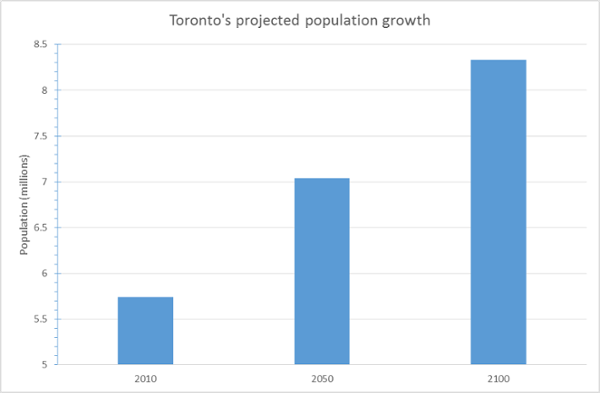A Big Hope – A Bigger and Better Toronto
Posted by Daniel Hoornweg on February 18, 2015
Toronto passed a major milestone last week. Statistics Canada stated the Toronto Census Metropolitan Area (CMA) population is 6,055,724. For the first time, the metro area population exceeds 6 million, and that does not include Oshawa-Whitby, Hamilton-Burlington, and Kitchener-Waterloo. An even bigger, more important, story is that the Toronto Urban Region as defined by the Global Cities Institute or thorough the Places to Grow Act now has a population larger than 8 million.
Toronto Urban Region (Greater Toronto-Hamilton Area) is the regional commuter-shed. Or another way to look at the region is that it is the place that anyone travelling overseas answers ‘Toronto’ when a stranger asks ‘what city are you from in Canada?’ But Toronto’s stature is not guaranteed. Sure Toronto seems big; it is about twice as large as metro Montreal, and is as big as Vancouver, Edmonton, Calgary, Winnipeg, and Ottawa combined.
Yet despite all the growth in the region, Toronto’s relative global standing is declining quickly. We are now about the world’s 60th largest city and by the end of the century may not even be in the Top 100. We only look big when compared to Vancouver and Winnipeg. In future we need to compare ourselves to Lagos, Dar es Salaam, and Mumbai.
Toronto will continue to get bigger this century. That’s important. But it is even more important that Toronto get better in the next several decades. The urban area, however you want to define it, has no metro governance. That is not an insurmountable problem, but as seen with the region’s transportation, waste management, housing and energy, regional improvements are urgently needed. All governments and utilities need to be more aware of the city-region’s challenges and opportunities. Toronto (UR) is not Thunder Bay or Halifax. One-size ideas can only go so far. Toronto’s relative contribution to the country’s economy will continue to grow. Toronto will continue to be Canada’s main portal to the world.

Toronto's projected population growth (Hoornweg and Pope, 2014)
How might Toronto be even better? Five inter-related regional priorities are evident: mobility, housing, energy, resilience, and accommodation.
Toronto’s transportation troubles are legion. With too much acrimony and too little investment, travelling around the region and in the heart of the city is difficult. A much greater emphasis on mobility is needed (this is also likely the best way to enhance the region’s economic competiveness). Metrolinx is a good start, but a more fundamental effort at improved mobility and connectivity is needed.
Affordable and resource-efficient housing goes hand-in-hand with transportation improvements. This is not just about building more roads and houses, but it also requires a fresh look at the housing industry and land development, both in the suburbs and in city-core. A possible first step would be to create a consolidated provincial ministry of the greater Toronto area.
Energy is a large potential selling feature for Toronto region. Our electricity is among the lowest carbon in the world. Along with Montreal and Vancouver the city region should promote electric vehicles. Gasoline and diesel, along with natural gas (mostly for heating and industry), provide more than two-thirds of the city’s energy. Here we need to electrify transportation and introduce natural gas rapid transit corridors. New energy needs should look at combined heat and power, including geothermal. The Toronto region should enter into a carbon trading (including innovation and learning) with a few other global ‘best practice’ cities such as Rio de Janeiro, Tokyo, and maybe Chicago and Paris.
Resilience is probably the most important future selling feature of Toronto region. Already it is one of the most resilient large cities in the world. It has a relatively moderate climate, lots of fresh water and local food, infrastructure and institutions are relatively good, and as it is not a coastal city, Toronto along with maybe Chicago, is probably the most resilient large city in the world. We can build on this, and become even more resilient, safe and secure. We are in an enviable position to announce to potential businesses, ‘you would be hard pressed to find a safer, greener, more secure, city than Toronto to locate your businesses.’ And we should be choosy – it is both an honor to live here and a shared responsibility to make this a strong and vibrant community.
Last, and most important, is accommodation. The cities that will do best in the 21st Century are those that make everyone feel welcome. Toronto’s growth is driven mostly by immigration. People want to move here. Scarborough, Jane and Finch, Barrie, Oshawa, and Kitchener, these communities need to accommodate those of other religions, customs and expectations. Similarly this is a city region that may, despite its warts and blemishes, be the envy of the world. We all need to do better than just ‘get along,’ we need to accommodate and invigorate, and make it easy for everyone to contribute.
Bigger is not always better, but the next 35 years will be a critical time for Toronto in right-sizing itself to the evolving landscape. The urban region needs to assume a larger role in Canada and the rest of the world, while it also gets more of the ‘little things’ right. From streetcars that work when it’s cold to fostering a sense of accommodation for new immigrants, building and managing a world class city is complicated. However today with some 6 million, or 8 million, residents all pulling in the same direction we can accomplish much. Let’s hope so. The world needs more Toronto today and tomorrow.
Filed under: Sustainability 101